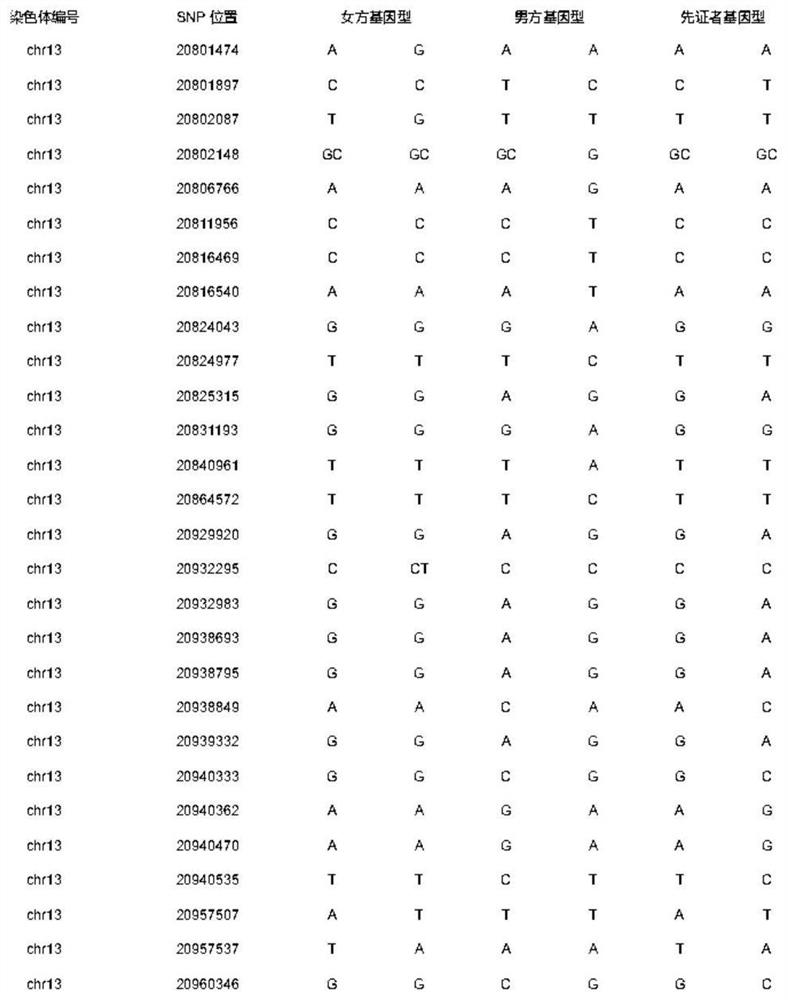Primer composition, kit and application for genetic detection of preimplantation hereditary deafness
A hereditary deafness and pre-embryo implantation technology, applied in the field of molecular biology, can solve the problems of high risk of misdiagnosis, long time-consuming, complicated operation, etc., to reduce the interference of results, improve accuracy, and reduce the risk of misdiagnosis
- Summary
- Abstract
- Description
- Claims
- Application Information
AI Technical Summary
Problems solved by technology
Method used
Image
Examples
Embodiment 1
[0059] Example 1 Analysis of pathogenic variants in family samples
[0060] 1. Sample preparation
[0061] The blood genomic DNA of both husband and wife and their affected offspring (proband) was extracted, the DNA concentration was measured by Qubit 2.0, and a certain amount was taken as the DNA sample to be tested.
[0062] 2. Target sequence capture and library construction
[0063] 1. Target Enrichment Capture
[0064] 1) After the DNA sample was vortexed and centrifuged, place it on an ice box, take two 0.2ml PCR tubes for each sample, and prepare the reaction system according to Table 3:
[0065] table 3
[0066] components Reaction volume (μl) dna sample 2(50ng) nuclease free water 4 5× Amplification Mixture 4
[0067] 2) After the preparation is completed, evenly distribute to two 0.2ml PCR tubes, 5μl in each tube. Add 5 μl of primer pool 1 to one tube, and 5 μl of primer pool 2 into the other tube, vortex to mix, and centrifuge...
Embodiment 2
[0101] Example 2 Pre-implantation detection of embryos
[0102] 1. Sample Preparation
[0103] Three to five cells from the trophectoderm of blastocyst-stage embryos were isolated as samples to be tested. The blastocyst stage embryos were sampled according to conventional embryo biopsy techniques, and the cells taken out were washed with 1×PBS (without Ca 2+ , Mg 2+ ) and washed 3 times, placed in a 0.2ml PCR tube with a volume not exceeding 2.5μl. Single-cell samples first use PicoPlex TM WGA kit for whole genome amplification.
[0104] 2. Target sequence capture and library construction
[0105] With embodiment 1.
[0106] The joints used for the 8 embryo samples to be tested G30218032601P01 to G30218032601P08 are SEQ ID NO.11 to SEQ ID NO.18 respectively.
[0107] 3. Fluorescent quantitative PCR to measure library concentration
[0108] With embodiment 1.
[0109] 4. On-machine sequencing and analysis of sequencing results
[0110] Dilute the library to 100pM, ta...
PUM
 Login to View More
Login to View More Abstract
Description
Claims
Application Information
 Login to View More
Login to View More - R&D
- Intellectual Property
- Life Sciences
- Materials
- Tech Scout
- Unparalleled Data Quality
- Higher Quality Content
- 60% Fewer Hallucinations
Browse by: Latest US Patents, China's latest patents, Technical Efficacy Thesaurus, Application Domain, Technology Topic, Popular Technical Reports.
© 2025 PatSnap. All rights reserved.Legal|Privacy policy|Modern Slavery Act Transparency Statement|Sitemap|About US| Contact US: help@patsnap.com



